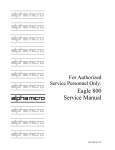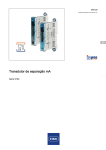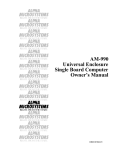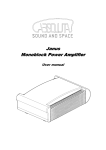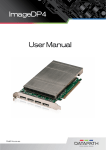Download Announcing the Eagle 450
Transcript
Marketing Bulletin AMB98-26 August 7, 1998 Announcing the Eagle 450 A new mid-range system with performance, price, and compatibility for the AMOS world Contents Announcing the Eagle 450............................................................................................................................... 1 Product Overview ............................................................................................................................................ 2 Where the Eagle 450 Fits in the AMOS Product Line.............................................................................. 2 ColdFire Technology ................................................................................................................................ 2 Quick Tour of the Processor ..................................................................................................................... 4 Eagle 450 Product Description ........................................................................................................................ 6 Chassis....................................................................................................................................................... 6 Memory ..................................................................................................................................................... 7 Serial I/O for the Eagle 450 ...................................................................................................................... 8 Eight Standard Ports ........................................................................................................................... 8 Optional Ports: AM-318-10................................................................................................................ 8 Optional Ports: Older I/O Cards ......................................................................................................... 8 Pinouts .............................................................................................................................................. 10 Surge Protection ............................................................................................................................... 10 Adapter Cables.................................................................................................................................. 11 Parallel Port............................................................................................................................................. 12 Ethernet Ports .......................................................................................................................................... 12 UPS Monitoring Port............................................................................................................................... 12 External SCSI Port .................................................................................................................................. 12 PCI Slots.................................................................................................................................................. 12 SCSI Support........................................................................................................................................... 14 SCSI Busses: Wide vs. Narrow ........................................................................................................ 14 SCSI Devices for the Eagle 450.............................................................................................................. 16 General Configuration Guidelines.................................................................................................... 16 Configuring a Wide SCSI System .................................................................................................... 16 AM-441-00 Wide SCSI Bus Repeater.............................................................................................. 18 SCSI Disk Drives.............................................................................................................................. 18 SCSI Tape Drives ............................................................................................................................. 18 AM-446 RAID Subsystem ............................................................................................................... 18 Portable CD-ROM Players ............................................................................................................... 19 AM-642 SCSI-to-Pertec Converter (“SToP Converter”) ................................................................. 19 SCSI Diskette Drive ......................................................................................................................... 20 Other Installation Considerations............................................................................................................ 21 Year 2000 Compliance ..................................................................................................................... 21 Software .................................................................................................................................................. 21 AMOS 2.3A Operating System ........................................................................................................ 21 TAME—TCP Management From Inside Your Aplication ............................................................... 21 Upgrades.................................................................................................................................................. 22 Upgrade Kits for Eagle 100/300/500 Systems ................................................................................. 22 Upgrade Kits for AM-1600 Systems ................................................................................................ 22 Benefits of Upgrading ...................................................................................................................... 22 System Performance................................................................................................................................ 23 System Index (SI) ............................................................................................................................. 23 DOABEN Performance .................................................................................................................... 24 The Bottom Line ..................................................................................................................................... 25 Announcing the Eagle 450 Dear Alpha Microsystems VAR: e are proud to announce the Eagle 450, a new AMOS-based computer system. The Eagle 450 brings the latest Alpha Microsystems technology, built around Motorola’s revolutionary ColdFire® processor, to the service of your applications and your customers. Highlights of this outstanding new product are as follows: W • First of a new generation of AMOS processors — The Eagle 450 is the first step in our migration from MC 680X0 CPUs to Motorola’s newest microprocessor family: ColdFire. These technically innovative chips offer an ideal fit for the AMOS world: high performance, attractive cost, and software compatibility. • The latest Alpha Micro technology — The Eagle 450 also embodies the latest technology from our own engineers. Leading-edge features include all-on-one-board processor design; RJ-45 serial ports with built-in lightning protection; and a wide SCSI bus. Network support includes TAME — short for TCP Access Made Easy — that lets you add TCP communications to any AlphaBASIC or AMOS assembly language application. • A new level of price/performance — The Eagle 450 is a mid-range system, with performance and connectivity in the same class with the Eagle 300 and Eagle 500. Expandability of the Eagle 450 is superior. Its price is lower. In fact, the Eagle 450 offers more performance per dollar than any Alpha Micro system we’ve built before. • PCI expansion slots — As a standard feature, the Eagle 450 provides two industry-standard slots for PCI expansion cards. Software support is planned for a future release. Like the adoption of the ColdFire CPU, our provision for PCI cards — used by the millions to implement optional features in PCs — brings new technical sizzle to the AMOS marketplace. • Easy to configure — It’s a snap to spec out an Eagle 450. Your choice of wide or narrow SCSI. Memory in any mix of one or two SIMMs, from 4MB to 256MB. Use AM-314, 318, or 318-10 cards for I/O expansion. A 10BaseT Ethernet port is standard. And the new streamlined deskside chassis, shipping now for all Eagle models, looks very sharp. • Easy to buy — Our Eagle 450 trade-in program makes business sense for current users of virtually any Alpha Micro small or mid-range computer. We offer field upgrades too, with kits for AM-1600 and Eagle 100, 300, and 500 systems. We want your business. • Our commitment to the future of AMOS — Roll-out of the Eagle 450 climaxes a two-year, technology-intensive development program. It’s evidence of our commitment to the future of the AMOS product line and to the AMOS community. ColdFire is a registered trademark of Motorola, Inc. Announcing the Eagle 450 AMB98-26 Page 2 ________________________________________________________________________________ Product Overview Where the Eagle 450 Fits in the AMOS Product Line Table 1 opposite shows where the Eagle 450 fits in the AMOS product line. A maximum of 32 serial ports makes the Eagle 450 a mid-range system, in a class with the Eagle 300 and Eagle 500. Performance is impressive. The Eagle 450’s ColdFire RISC CPU yields an SI (System Index) rating of 68.5. That’s faster than an AM-4000, a much larger and more expensive system. Other advanced features of the Eagle 450 include: • Memory from 4MB to 256MB — the widest range of choices we’ve ever offered. • A Wide SCSI bus for maximum throughput with high-performance peripherals; the system can be ordered with a narrow (8-bit) SCSI bus instead. • Two PCI expansion slots are standard. These are the same slots found in most PCs today, used for add-in features. We intend to support selected PCI cards on future releases; support is not offered at this time. • The Eagle 450 is a superb upgrade vehicle for an existing Eagle 100, Eagle 300, or AM-1600 system. Install an Eagle 450 upgrade kit and get twice the CPU horsepower, improved Ethernet, more memory capacity, and a Wide SCSI bus for top peripheral performance. ColdFire Technology In the Eagle 450, all CPU and I/O logic is implemented on a single board. At the heart is a Motorola ColdFire processor chip. ColdFire is a microprocessor family with strength in three areas vital to AMOS computers. The areas are high performance, attractive cost, and software compatibility. Motorola conceived ColdFire as a new branch of the MC680X0 family tree. To meet targets for performance, compatibility, and cost, Motorola developed Variable-Length RISC technology. VL RISC unites the architectural simplicity of conventional 32-bit fixed-length RISC with a fastexecuting, memory-saving, variable-length instruction set. Motorola has a long-range plan for ColdFire. The plan defines a series of architectural upgrades coupled with projected advances in processor technology. The result will be ColdFire CPUs with power well beyond the 68K family. For example, Motorola envisions a ColdFire chip with performance in the area of 300 MIPS — far faster than the 68060 we use in the AM-6000. Our long-term objective is a whole new line of AMOS systems, all drawing on the cost-effective power of ColdFire and all preserving the compatibility to support your applications. The Eagle 450 is where that line begins. Announcing the Eagle 450 AMB98-26 Page 3 ________________________________________________________________________________ Eagle 450 — A mid-range system with more CPU speed than an AM-4000 Table 1. AMOS Product Line Popular AMOS-based Systems* Eagle 100 Eagle 300 Eagle 450 Eagle 500 Super Eagle AM-6000 39.1 39.1 68.5 79.9 79.9 137.0 CPU MC68030 MC68030 ColdFire RISC MC68040 MC68040 MC68060 Memory: min./max. 4MB/32MB 4MB/32MB 4MB/256MB 4MB/64MB 4MB/64MB 8MB/256MB -- -- Available -- -- Available Serial ports, standard 8 8 8 8 4 4 Serial ports, maximum 16 32 32 32 200+ 200+ AM-314 / 318 AM-314 / 318 AM-314 / 318 AM-314 / 318 AM-359 AM-359 1 2 1 2 4 4 Optional; AM-366 card required Standard; integrated on system board Standard; integrated on system board Standard; integrated on system board Standard; integrated on system board Standard; integrated on system board Optional Standard Standard Standard Standard Standard Consumes a serial port Consumes a serial port Dedicated UPS port Consumes a serial port Dedicated UPS port Dedicated UPS port Opt. (AM-338) Opt. (AM-338) Opt. (AM-338) Opt. (AM-338) -- -- -- -- 2 PCI slots, standard -- -- -- 2.3A 2.2C 1.4C, 1.4E 2.3A 2.2C 1.4C, 1.4E 2.3A 2.2C 1.4C, 1.4E 2.3A 2.2C 2.3A System Performance: SI 16-bit, Wide SCSI bus Input/Output I/O Expansion Cards Parallel Ports Networking Ethernet Controller 10BaseT (twisted pair) Ethernet Port UPS Monitoring Bisync RJE PCI Expansion Slots for PCI add-in cards (future support) AMOS AMOS Versions Supported 2.3A Notes * Other models, not shown here: Falcon, Eagle 100LC, AM-4000, and AM-6060 Network Server. 512MB memory available on systems with processor board at appropriate revision level. 10BaseT Ethernet port furnished as standard on AM-319-20 System Board; optional on AM-176 processor board. Not supported on initial product release. Announcing the Eagle 450 AMB98-26 Page 4 ________________________________________________________________________________ Quick Tour of the Processor The Eagle 450’s single-board processor, the model AM-138, is the latest in our long line of powerful, versatile single-board CPUs. Follow the numbered callouts in Figure 1 opposite for a quick tour of the AM-138. 1 Memory — Two SIMM slots accommodate main memory from 4MB to 256MB. See memory configurator on page 7 for details. 2 Cache — 64KB external cache for maximum CPU performance; mounted on plug-in card. 3 Expansion slots — Three AM-318 style, serial I/O expansion slots; accessible at rear panel. 4 Standard serial I/O — Eight standard serial ports; see page 8 for configuration guidelines. 5 SSD chip — Same chip as used in Roadrunner boards and other Eagle systems. 6 UPS port — Dedicated DB-9 port for UPS monitoring; see page 12. 7 Parallel port — DB-25 parallel printer port. 8 CMOS setup — Flexible, terminal-driven setup facility replaces boot switches. 9 Ethernet port — AUI and 10BaseT (twisted-pair) Ethernet ports are standard equipment. 10 Ethernet controller — 16-bit, dual-port, Ethernet controller; much faster than an AM-366. 11 PCI expansion slots — Connector slots for two PCI expansion cards. This unique feature of the Eagle 450 will allow cost-effective, plug-in expansion using industry-standard PCI cards. Planned for support on a future release, PCI add-ins are not available at this time. See page 12 for further information. 12 68K-to-PCI Bridge — Key to PCI compatibility, this controller-on-chip bridges the gap between MC68000 architecture and PCI architecture. 13 Narrow SCSI bus — 50-pin connector for bus on narrow SCSI Eagle 450. 14 Wide SCSI bus — 68-pin connector for bus on Wide SCSI Eagle 450 (a miniaturized design, physically smaller than the 50-pin narrow SCSI connector). 15 SCSI controller — 32-bit, bus-master RISC processor. 16 R & D test point — Socket for connecting test equipment (logic analyzer) during engineering development; to be phased out during initial production run. 17 Motorola ColdFire processor — Small but powerful CPU, embodying Motorola’s innovative Variable-Length RISC architecture, delivers big-system throughput for the mid-range Eagle 450. Announcing the Eagle 450 AMB98-26 Page 5 ________________________________________________________________________________ 6 UPS port 7 Parallel port 8 CMOS Setup 9 Ethernet: AUI and 10BaseT 10 Ethernet Controller 5 SSD chip 11 PCI Expansion Slots 4 Standard serial I/O; 8 ports 3 Expansion slots, AM-318 style 12 68K-toPCI Bridge Controller 13 Narrow SCSI bus 14 Wide SCSI bus 15 SCSI Controller 2 64KB Cache 1 Memory to 256MB 16 R & D Test point 17 ColdFire Processor Figure 1. AM-138 Processor Board Announcing the Eagle 450 AMB98-26 Page 6 ________________________________________________________________________________ Eagle 450 Product Description Chassis The Eagle 450 is furnished in the new, streamlined, Eagle deskside chassis. Specifications are as follows: • Dimensions—17¾" high x 9" wide x 17" deep (44.5 cm x 22.9 x 43.1) • Power requirement—5 amp @ 115VAC; 2.5 amp @ 230VAC • Peripheral mounting—The chassis accommodates up to six peripheral devices. Figure 2 shows details. Three 5.25" device bays, all front-accessible. See Note* Front panel display occupies this bay One 3.5" device bay, front-accessible Two 3.5" device bays, hidden * Note — Optional Wide SCSI Bus Repeater occupies one 5.25" device bay, if installed. (Any of the three 5.25" bays shown in the diagram can be used.) This is not a significant configuration limit, considering the small physical size and large storage capacity of current peripherals. Cutaway view from left side Figure 2. Eagle 450 Chassis: Peripheral Mounting Bays Announcing the Eagle 450 AMB98-26 Page 7 ________________________________________________________________________________ Memory The Eagle 450 supports a minimum of 4MB and a maximum of 256MB of main memory. Using a new, flexible, memory architecture, the processor is equipped with two SIMM sockets. Any combination of one or two PFB-00712-XX SIMMs can be installed. Upgrades are easy. If an Eagle 450 has one SIMM installed and needs more memory, just add a second SIMM. Table 2 below shows all allowable SIMM combinations. Table 2. Eagle 450 Memory Configurator Install these memory SIMMs... ↓ ↓ PFB-00712-04 4MB Memory, 60ns PFB-00712-08 8MB Memory, 60ns PFB-00712-16 16MB Memory, 60ns PFB-00712-32 32MB Memory, 60ns PFB-00712-64 64MB Memory, 60ns PFB-00712-C8 128MB Memory, 60ns PFB-00712-04 4MB Memory, 60ns PFB-00712-08 8MB Memory, 60ns PFB-00712-16 16MB Memory, 60ns PFB-00712-32 32MB Memory, 60ns PFB-00712-64 64MB Memory, 60ns PFB-00712-C8 128MB Memory, 60ns … to obtain this amount of Main Memory 4 8 8 12 16 16 20 24 32 32 36 40 48 64 MB MB MB MB MB MB MB MB MB MB MB MB MB MB 1 *2 1 *1 1 1 2 1 1 1 1 1 1 2 1 1 1 1 1 64 68 72 80 96 128 128 132 136 144 160 192 256 MB MB MB MB MB MB MB 1 MB MB MB MB 1 1 1 1 1 MB 1 1 1 MB 2 1 1 1 1 2 1 1 1 1 1 1 1 2 * Example — You can make an 8MB system with two 4MB SIMMs or one 8MB SIMM. New flexibility for a mid-range system: use 1 or 2 SIMMs in any mix of sizes. Announcing the Eagle 450 AMB98-26 Page 8 ________________________________________________________________________________ Serial I/O for the Eagle 450 The Eagle 450 comes equipped with eight serial ports as standard. The processor board includes three AM-318 style expansion slots, accommodating up to 24 additional ports. All ports mount in Centronics-style cutouts in the rear of the chassis. See Figure 3. This versatile arrangement fits the full range of I/O boards in the AM-314 / AM-318 family. Eight Standard Ports The eight standard ports are driven directly from the system processor board. A cable harness leads from the processor board to eight RJ-45 ports in the rear panel. See (A) in Figure 3. The ports provide full modem control, Super I/O compatibility, and built-in lightning protection. Pinouts are the same as those on an AM-359 card. Optional Ports: AM-318-10 Introduced this past January, the AM-318-10 is a highly-featured, technically-advanced, serial I/O interface. The card provides eight RJ-45 ports, with full modem control, Super I/O compatibility, and built-in lightning protection. See (B) in Figure 3. You can configure an AM-318-10 in each of the Eagle 450’s three I/O expansion slots. Three cards plus the eight standard ports provide the maximum system configuration of 32 serial ports. Optional Ports: Older I/O Cards For optimum fit with your existing customer sites and your existing parts inventory, we designed the Eagle 450 to use older I/O cards as well as the new AM-318-10. See (C) in Figure 3. All of the following are fully compatible: AM-314 — The AM-314 provides four DB-9 serial ports. In the Eagle 450, each Centronics-style cutout accommodates two DB-9 connectors. The connectors mount in a DWF-20519-04 Adapter. A set of four adapters comes with the Eagle 450; order more if needed. You can add AM-90 boards for RJ-45 connectors and lightning protection. AM-318 — The original AM-318 provides eight serial ports, presented to the user at a single RJ-21 50-pin telco connector. The connector occupies one Centronics cutout. AM-318-02 — This product combines the circuit board of the original AM-318 with eight RJ-45 ports. Lightning protection is provided, but not full modem control. Announcing the Eagle 450 AMB98-26 Page 9 ________________________________________________________________________________ Rear panel of Eagle 450 chassis Eagle 450 supports up to 32 serial ports. Ports are mounted in these eight Centronics-style cutouts. C Eagle 450 also accepts older I/O cards. Each cutout accommodates: Two DB-9 ports B Typical option: (from AM-314), or One RJ-21 telco connector (from AM-318) AM-318-10 provides eight RJ-45 serial ports A Eight RJ-45 serial ports: standard feature of Eagle 450 Figure 3. Eagle 450 Serial Ports Announcing the Eagle 450 AMB98-26 Page 10 ________________________________________________________________________________ Pinouts The standard serial ports on the Eagle 450, and the ports on the optional AM-318-10 card, are RJ-45 modular jacks. This interface presents the same pinouts as an AM-359 card, and provides full modem control. Another serial port option compatible with the Eagle 450, and also providing RJ-45 ports, is the AM-318-02. The ports look the same from the outside but the pinouts are different. See the table in Figure 4 for details. Because of the difference in wiring, the AM-318-02 does not provide full modem control. RJ-45 pins that are active in this Eagle 450 serial port implementation: Pins: 12345678 View from outside the Eagle 450 chassis, looking into an RJ-45 serial port Pin No. 1 2 3 4 5 6 7 8 Description Chassis Ground (shield) Clear to Send Transmit Data Request to Send Receive Data Data Terminal Ready Signal Ground Data Carrier Detect GND CTS TXD RTS RXD DTR GND DCD Standard 8 ports AM-318-10 AM-318-02 ✔ ✔ ✔ ✔ ✔ ✔ ✔ ✔ ✔ ✔ ✔ ✔ ✔ ✔ ✔ ✔ ✔ ✔ ✔ ✔ ✔ ✔ Figure 4. RJ-45 Pinouts on Eagle 450 Surge Protection Surge protection is a standard feature of RJ-45 serial ports on the Eagle 450. Protection is implemented by an array of zener diodes, sometimes called avalanche diodes. The diodes are mounted on AM-90 Lightning boards furnished as part of the port assembly. If an over-voltage condition occurs on the serial I/O cable, the diodes react—in nanoseconds—to divert the flow of current away from sensitive I/O circuitry. A system that’s installed and grounded in accordance with Alpha Micro standard practice should withstand virtually any power surge without damage. However, the exact characteristics of power surges are difficult to predict. (Consider what can happen, for example, when a high-voltage power line comes loose in a storm and drops across telephone wires carrying modem traffic.) The presence of AM-90 Lightning boards, therefore, does not affect our warranty coverage. An AM-90 Lightning board protects the system inside which the board is installed. Surge protection for terminals or other far-end devices, if desired, must be implemented by other means. Announcing the Eagle 450 AMB98-26 Page 11 ________________________________________________________________________________ Adapter Cables I/O cables at existing Alpha Micro sites may terminate in DB-9 connectors, modem connectors, patch cord hookups, or other connectors not directly compatible with the RJ-45 ports on the Eagle 450. We offer adapter cables and connectors to provide the necessary compatibility. Table 3 gives a list. For pinouts and other details see Appendix A in PDI-00359-00, AM-359 Eight-Port Serial I/O Board; Installation Instructions. The document is available at our Web site. The same information will appear in the Eagle 450 Installation and Technical Manual. Table 3. Serial I/O Adapter Cables Cable Connectors Nearest to AM-318-10 Connector(s) on Far End of Cable or Adapter PDB-00359-50 Cable Set, AM-359* to AM-355, 8 Cable 8 x RJ-45 8 x DB-9 female For installations where the AM-318-10 will connect to existing DB-9 cables. Example: a site being upgraded from an older Alpha Micro system, which used AM-355 serial I/O cards. PDB-00359-51 Cable, AM-358 Conv, 8P6W 8 x RJ-45 1 x RJ-21 female Connects the AM-318-10 to a 6-wire patch panel. PDB-00359-52 Cable Set, AM-359* 6P8W + 2 FDB9 6 x RJ-45 1 x RJ-21 female + 2 x DB-9 female Connects the AM-318-10 to an 8-wire patch panel that uses a 4-pair wiring system. PDB-00359-53 Adapter Set (4), RJ45 MDB25 Modem 4 x RJ-45 4 x DB-25 male Connects the AM-318-10 to modems. 8-wire patch cords also required; see PDB-00359-56. PDB-00359-54 Adapter Set (4), RJ45 MDB25 CRT 4 x RJ-45 4 x DB-25 male Connects the AM-318-10 to printers or terminals. 8-wire patch cords also required; see PDB-00359-56. PDB-00359-55 Adapter Set (4), RJ45 FDB9 PC-AT 4 x RJ-45 4 x DB-9 female Connects the AM-318-10 to PC-AT style serial port. 8-wire patch cords also required; see PDB-00359-56. PDB-00359-56 Cable Set (4), RJ45 Straight, 10-ft. 4 x RJ-45 Cable Part Number and Description 4 x RJ-45 Remarks 10-foot, shielded, parallel (straight-through) patch cords; for use with adapters listed above. * Originally developed for the AM-359 card, this cable works the same way with an AM-318-10 or with the eight standard ports on an Eagle 450, all of which have the same RJ-45 pinouts. Announcing the Eagle 450 AMB98-26 Page 12 ________________________________________________________________________________ Parallel Port The Eagle 450 is equipped with one DB-25 parallel port. See Figure 5. The port is functionally identical to the parallel port on an Eagle 100. Ethernet Ports Ethernet connectivity is a standard feature of the Eagle 450. Two ports are provided: an RJ-45 jack for connection to a 10BaseT Ethernet and a DB-15 connector for attaching an AUI. You can use either port, but not both at the same time. The Eagle 450 uses an Ethernet controller-on-a-chip (National Semiconductor DP83902) integrated on the processor board. The controller provides efficient, high-throughput operation at 10 megabits per second. Fast Ethernet (100BaseT) is planned as an optional feature on a future release. UPS Monitoring Port The Eagle 450 includes a dedicated DB-9 port for monitoring the switch contacts in an attached uninterruptible power supply. See Figure 5. The switch contacts give basic UPS status information, such as power fail and low battery. A separate connection, from the UPS to a serial port, is required if the user wishes to observe software-monitored functions, such as load, voltage, and fault status. External SCSI Port The external SCSI port is the attachment point for a SCSI terminator or for the cable from an external SCSI device. See “SCSI Devices for the Eagle 450,” below, for configuration information. PCI Slots PCI, short for Peripheral Component Interconnect, is the dominant local bus technology in Intelbased PCs and servers. Mass production for this huge market has produced PCI add-in boards, such as disk controllers and LAN cards, with excellent performance and low prices. The use of PCI is spreading beyond PCs into industrial equipment. This in turn has stimulated the development of bridge technology for interfacing PCI cards to Motorola circuitry. Our engineers have implemented that technology on the Eagle 450 processor board in the form of two PCI card slots. Each slot is a 120-pin connector. When a standard PCI card is plugged into the slot, the external connector on the card will be accessible at the Eagle 450 rear panel in customary PC fashion. We envision a number of applications for PCI cards in the AMOS environment. Software support for such applications awaits development. Until then, the slots are concealed behind a cover plate on the rear panel. Please watch for news of PCI applications for the AMOS world. Announcing the Eagle 450 AMB98-26 Page 13 ________________________________________________________________________________ External SCSI Connector — Terminator, or cable from external SCSI device, attaches here. PCI Slots — Eagle 450 includes two industrystandard connectors for PCI expansion cards. Slots are secured behind an external cover plate; software support is under development for future implementation. Ethernet Ports 10BaseT (RJ-45) AUI (DB-15) Parallel Port (DB-25) UPS Monitoring Port (DB-9) Figure 5. Eagle 450 Ports Announcing the Eagle 450 AMB98-26 Page 14 ________________________________________________________________________________ SCSI Support The Eagle 450 incorporates our latest and most powerful SCSI technology, including a Wide SCSI bus for connection to high performance peripherals. This page explains your choice in busses: wide or narrow. Configuration rules for individual SCSI devices start on page 16. SCSI Busses: Wide vs. Narrow The Eagle 450 includes a 32-bit bus-master SCSI controller, integrated on the AM-138 processor board. As standard, the board provides two interfaces from the controller to SCSI devices. One interface is a 50-pin narrow SCSI connector. The other is a 68-pin Wide SCSI connector. See the illustration of the AM-138 board on page 5. In an installed Eagle 450, a bus cable runs from one, and only one, of the two connectors to all SCSI devices in the system. Your choices are: • A 50-conductor SCSI cable is furnished when you order a Narrow SCSI Eagle 450 System, part number SBC-EG450-01. This is the same type of SCSI cable used in earlier Eagle systems and in Roadrunner 030 and 040 systems. The bus is one byte wide (8 bits plus parity) and supports a maximum transfer rate of 10 megabytes per second. • A 68-conductor Wide SCSI cable is furnished when you order a Wide SCSI Eagle 450 System, part number SBC-EG450-02. The Wide SCSI bus is two bytes wide and supports a maximum transfer rate of 20MB per second. Disk-intensive applications are potentially faster with the Wide SCSI bus and a Wide SCSI disk drive. Wide SCSI also has the advantage in multi-disk configurations. Spreading a file and its index across two Wide SCSI disks, for example, boosts the performance advantage of each disk. The two bus cables are mutually exclusive. Mixes, with some devices on one bus and some on the other, are not supported. Table 4 opposite summarizes the characteristics of the two busses. If You Order an Eagle 450 with Narrow SCSI (SBC-EG450-01): An Eagle 450 in the narrow SCSI configuration supports our familiar SCSI-2 disk drives (part number PDB-00436-XX), tape streamers, DATs, and other narrow SCSI peripherals. The system will also accept Wide SCSI devices. Examples include Fast-Wide SCSI-2 disks, such as our PDB-00440-XX 2.1GB and 4.3GB drives, and the 26GB ¼-inch cartridge tape streamer. Each such device requires a PDB-00440-90 Adapter to mate with the 50-pin SCSI cable. In this environment, Fast-Wide devices will perform at about the same speed as narrow SCSI-2 devices. If You Order an Eagle 450 with Wide SCSI System (SBC-EG450-02): For maximum system throughput, order the Eagle 450 in the Wide SCSI configuration. Data moves in and out of the disk buffers faster because the interface to the system is 16 bits wide, instead of the 8-bit path used in SCSI-2 drives. The Wide SCSI bus cable provides 68-pin connectors that mate directly with the 68-pin connectors on Fast-Wide SCSI-2 devices. Announcing the Eagle 450 AMB98-26 Page 15 ________________________________________________________________________________ Table 4. Choice of SCSI Busses in the Eagle 450 Narrow SCSI Bus Wide SCSI Bus Availability Availability in the Eagle 450 Standard in SBC-EG450-01 Eagle 450, Narrow SCSI Standard in SBC-EG450-02 Eagle 450, Wide SCSI Optional upgrade for system originally with narrow SCSI Bus width One byte (8 bits + parity) Two bytes (16 bits + parity) Maximum transfer rate 10 Mbytes/sec 20 Mbytes/sec Maximum number of SCSI devices you can connect to the bus 7 total, including internal and external devices Internal: 5 devices, maximum External: Depends on cable length; up to 8 feet allowed with AM-441 SCSI Repeater. Connectors on bus for attaching devices 50-pin 68-pin Technology Connection to SCSI Devices How peripherals connect to the bus: Devices with 50-pin SCSI Connector SCSI-2 disks (“narrow disks”) Streamer tapes, 2GB or less DAT tapes Other standard SCSI-2 devices Devices with 68-pin Wide SCSI Conn. Fast-Wide SCSI-2 or UltraSCSI disks 26GB ¼" streamer tape External SCSI Connector These devices connect directly to the SCSI bus, same as in Roadrunner 030 and 040 systems, Eagle 100, and earlier Eagle systems. Each device requires a Each 50-pin device requires a PDB-00440-91 Adapter to connect to the Wide SCSI bus. PDB-00440-90 Adapter to connect to the SCSI bus. Since these devices have a 68-pin data connector, they connect directly to the 68-pin Wide SCSI bus. 50-pin connector, same as in Roadrunner and other Eagles. Installation kit includes 50-pin SCSI terminator. 68-pin Wide SCSI external connector. Installation kit includes 68-pin Wide SCSI Active Terminator. Wide SCSI disks will be no faster than narrow disks. Not recommended: Wide SCSI performance advantage will be sacrificed. Recommendations What happens when wide and narrow SCSI disk drives are installed in the same system? Your Decision — The Eagle 450 is available with either bus style. We recommend the following for maximum performance: Order the Wide SCSI configuration: SBC-EG450-02. Order Wide SCSI disk drives (part number PDB-00440-XX). Order a PDB-00440-91 Adapter for each narrow SCSI device in the system. Announcing the Eagle 450 AMB98-26 Page 16 ________________________________________________________________________________ The Wide SCSI bus also accommodates Ultra SCSI disk drives. With present Eagle 450 hardware and software, Ultra SCSI drives provide the same performance as Fast-Wide SCSI-2 disk drives. When you order a Wide SCSI Eagle 450, you’ll also need to order a PDB-00440-91 Adapter for each narrow SCSI-2 device, such as a 525MB or other prior model tape streamer. The adapter is a 50-to-68-pin width-changer that lets narrow devices connect to the wide bus. SCSI Devices for the Eagle 450 A wide choice of disks, tapes, and other SCSI devices helps tailor the Eagle 450 to specific site requirements. Table 5 summarizes current offerings. The system supports up to five SCSI devices mounted inside the system chassis (internal devices). Additional SCSI devices can be installed outside the chassis (external devices). General Configuration Guidelines Each SCSI device requires mounting space and a connection to the SCSI bus. Table 5 shows the type of connection that each device requires: narrow SCSI or Wide SCSI. Mounting requirements are shown for internal devices. See the Eagle 450 chassis diagram on page 6 for bay locations inside the chassis. Configuring a Wide SCSI System The electrical characteristics of the Wide SCSI bus, and the high bit-transmission rates it permits, impose added configuration rules. The following should be noted: 1. With a standard Wide SCSI Eagle 450, the maximum length of external cabling, starting from the external SCSI connector on the chassis, is three feet (91 cm). In practice that usually means a maximum of one external device. 2. Adding the optional AM-441-00 Wide SCSI Bus Repeater, described below, increases the maximum external cable length to eight feet (243 cm). That amount of cabling will normally allow up to three external devices. 3. If the external devices include a mix of Wide SCSI and narrow SCSI, the narrow devices must be grouped at the outboard end of the cabling, farthest from the chassis. 4. An external cable is standard with some devices and optional with others. We offer the cables listed in Table 6. If you plan to supply your own cables, make sure they’re fabricated to SCSI-2 construction standards. Announcing the Eagle 450 AMB98-26 Page 17 ________________________________________________________________________________ 9GB disk drive now available for AMOS systems Table 5. SCSI Devices for the Eagle 450* Part Number Description Interface† Mounting Bay Remarks Internal Devices PDB-00436-XX SCSI-2 Disk Drives PDB-00440-XX Fast-Wide SCSI-2 Disk Drives PDB-0062X-00 ¼" Tape Streamers PDB-00650-00 ¼" Tape Streamer, 13/26GB PDB-00649-XX DAT Tape Drives PDB-00212-20 N 50-pin 3.5" 1GB, 2GB; see current AMOS price list for compatible models W 68-pin 3.5" 2.1GB, 4.3GB, 9GB 50-pin 5.25" 525MB, 1GB, 2GB, 4/8GB. See bulletin AMB98-20; 6 Jun 98 W 68-pin 5.25" See bulletin AMB97-30; 27 Aug 97 N 50-pin 5.25" 4GB, 8GB 3.5" Diskette Drive, SCSI N 50-pin 3.5" New product — Attaches to SCSI bus; no floppy controller required PDB-00401-51 CD-ROM, Internal, SCSI N 50-pin 5.25" PDB-00441-00 Wide SCSI Bus Repeater W 68-pin 5.25" N Does not count as a ‘SCSI Device’ External Devices PDB-00446-XX AM-446 RAID Subsystem PDB-00401-50 CD-ROM, External, SCSI N 50-pin PDB-00642-00 SCSI-to-Pertec Converter, Ext. N 50-pin - - - PDB-03501-00 W 68-pin Portable CD-ROM players AM-3501 Expansion Subsystem See bulletin AMB97-41; 22 Dec 97 See accompanying text for cables See accompanying text for cables N W Either Not a SCSI device itself; provides mounting for up to four half-height, Wide or narrow SCSI devices. Connects to Wide or narrow AMOS host system. For any external device on a Wide SCSI system: do not use a cable longer than 3 ft unless the system is equipped with a Wide SCSI Bus Repeater. * As of August 1998. New devices, higher capacities, and more cost-effective configurations are constantly being added. See Marketing Bulletins, or call your Order Administrator, for the latest information. † N = narrow SCSI bus; W = Wide SCSI bus. Announcing the Eagle 450 AMB98-26 Page 18 ________________________________________________________________________________ AM-441-00 Wide SCSI Bus Repeater The Wide SCSI Bus Repeater is an optional hardware feature for systems equipped with the Wide SCSI bus. The Repeater acts as a booster to electronically extend the Wide SCSI bus. The Repeater does not count as a SCSI device itself. As noted above, the Repeater is mandatory if more than three feet of SCSI cabling will be installed outside the chassis. The Repeater occupies one 5.25" device bay in the system chassis. The Repeater is not required if all SCSI devices are installed inside the Eagle 450’s deskside chassis. The Repeater works in Wide SCSI systems only. In systems equipped with the narrow SCSI bus, the Repeater is not required and is not installable. For more information see Marketing Bulletin AMB98-04, New Wide SCSI Versatility — Shipping Now, January 23, 1998. SCSI Disk Drives The Eagle 450 supports all currently available SCSI-2 disk drives, including narrow SCSI drives (PDB-00436-XX) and Fast-Wide SCSI-2 drives (PDB-00440-XX). SCSI Tape Drives The Eagle 450 supports all current SCSI tape drives. Models include the AM-62X family of ¼" streamers; AM-649-XX DAT drives; and the AM-650, a Wide SCSI ¼" streamer that stores up to 26GB on a single tape cartridge. AM-446 RAID Subsystem For Eagle 450 installations that require large, highly reliable mass storage, specify our AM-446 RAID Subsystem. Configurations start as small as 4.3GB of usable storage with RAID 1 (mirroring). The subsystem can be expanded to over 60GB of RAID 5 storage in the same desktop enclosure. Disk drives are UltraWide SCSI with 40 megabytes per second transfer rate. The AM-446 includes facilities for system installers and support managers to: • Configure the AM-446 with hot spare or warm spare disk drives for on-site support. • Manage, monitor, and configure the AM-446 by communication from a remote site. The AM-446 can automatically transmit e-mail messages to report its own system status, including errors and out-of-range conditions. • Configure the AM-446 as a bootable SCSI device; the subsystem can coexist with other SCSI disk drives in the same Eagle 450. For more information see Marketing Bulletin AMB97-41, AM-446 RAID Subsystem Announced, Dec. 22, 1997. Announcing the Eagle 450 AMB98-26 Page 19 ________________________________________________________________________________ Table 6. External SCSI Cables Use This Cable to Connect Chassis to Device External SCSI Connector on Eagle 450 Chassis Connector on External SCSI Device Cable Part Number Description 68-pin 50-pin PDB-00440-80 Cable, 50-pin Centronics to 68-pin Ext. SCSI, 3 ft. 68-pin 50-pin PDB-00440-81 Cable, 50-pin Centronics to 68-pin Ext. SCSI, 6 ft.* 68-pin 68-pin PDB-00440-82 Cable, Wide SCSI, 68-pin/Male, 68-pin Male, 6 ft.* 68-pin 68-pin PDB-00440-83 Cable, Wide SCSI, 68-pin/Male, 68-pin Male, 3 ft. * To use a 6 ft. cable and stay within Wide SCSI cable guidelines, an Eagle 450 must be equipped with the AM-441-00 Wide SCSI Bus Repeater. ________________________________________________________________________________ Portable CD-ROM Players Many Alpha Micro VARs and developers use a portable CD-ROM player to load software at customer sites. If you do, you’ll need a 68-pin cable to connect to a Wide SCSI Eagle 450. Order a PDB-00440-81 External SCSI cable (50-pin Centronics connector to 68-pin External SCSI, 3 ft) and keep it with the CD-ROM player. Do not use a cable longer than three feet unless the Eagle 450 is equipped with an AM-441-00 Wide SCSI Bus Repeater. AM-642 SCSI-to-Pertec Converter (“SToP Converter”) The AM-642 is an interface unit that connects an AMOS-based host system to a Pertec-compatible ½" tape drive. The external version, model AM-642-00, is mounted in a desktop chassis and cabled to the host. Cabling arrangements are as follows: • With a Narrow SCSI Eagle 450 — The AM-642-00 comes with a 3 ft. (0.9m), 50-conductor cable. Plug the cable to the external 50-pin SCSI connector on a narrow SCSI Eagle 450 • With a Wide SCSI Eagle 450 — For a Wide SCSI Eagle 450, order one of the following SCSI cables to connect the AM-642 to the Wide SCSI external connector on the system chassis: - PDB-00440-80 Cable, 50-pin Centronics to 68-pin External SCSI, 3 ft. - PDB-00440-81 Cable, 50-pin Centronics to 68-pin External SCSI, 6 ft. To use the 6 ft. cable, the system must be equipped with an AM-441-00 Wide SCSI Bus Repeater. Announcing the Eagle 450 AMB98-26 Page 20 ________________________________________________________________________________ SCSI Diskette Drive The Eagle 450 supports our new SCSI-interface diskette drive, the AM-212-20, as an optional feature. The drive has a narrow SCSI (50-pin) interface that connects directly to the SCSI bus. No separate controller is required. The drive is somewhat more expensive than the PC-style drives used in most other AMOS-based systems. Elimination of the separate floppy controller, however, yields a lower total cost per system. Note: Diskette Drive Requires 5.25" Mounting Bay Although the AM-212-20 diskette drive is a 3.5" device, the complete assembly, including the mounting adapter for the drive, requires a 5.25" mounting bay in the system chassis. The AM-212-20 reads and writes 3.5" diskettes in all of the following formats: • • • • AMOS 720MB 3.5" double density format AMOS 1.44MB 3.5" high density format PC 720MB 3.5" double density format PC 1.44MB 3.5" high density format The Eagle 450 does not support 5.25" diskettes. The Eagle 450 does not require — or support — the AM-219 Floppy Controller. Announcing the Eagle 450 AMB98-26 Page 21 ________________________________________________________________________________ Other Installation Considerations Year 2000 Compliance When used with the AMOS 2.3A operating system, the Eagle 450 is Year 2000 compliant. For further information about Year 2000 compliance, visit our Web sites at www.alphamicro.com or www.amos-online.com; or call our Year 2000 Help Desk at (800) 777-7534; or see marketing bulletins entitled Progress Reports on Year 2000 Compliance, published by Alpha Microsystems from time to time. Software AMOS 2.3A Operating System The Eagle 450 runs under AMOS 2.3A and later versions of the AMOS operating system. If your application is running under an earlier release and you’d like help in moving to 2.3A, please call the Technical Assistance Center. We’re here to help you add still greater value to your application in the Alpha Micro world. TAME—TCP Management From Inside Your Application The network software included with AMOS 2.3A includes AlphaTCP 1.4, the latest version of our AMOS-compatible implementation of the TCP/IP protocol family. AlphaTCP 1.4 in turn includes TAME, for TCP Access Made Easy. TAME lets you add TCP communication to any AlphaBASIC or AMOS assembly language application. To access TCP from an assembly language program, you use a series of monitor calls. From AlphaBASIC or AlphaBASIC PLUS, you use the new TCP XCALL subroutine. AlphaTCP 1.4 software and documentation are available on the AlphaCD (December 1997 and later versions). Documentation is also available at our Web site. For details of TAME, see latest revisions of the AMOS Monitor Calls Manual and the AlphaBASIC XCALL Subroutine User’s Manual. Announcing the Eagle 450 AMB98-26 Page 22 ________________________________________________________________________________ Upgrades Users of many older Alpha Micro computers can enjoy most benefits of the Eagle 450, at reduced prices, by means of the Eagle 450 Upgrade Program. The program offers field-installable upgrade kits for Eagle 100, 300, and 500 systems, and for the AM-1600. Upgrade Kits for Eagle 100/300/500 Systems These upgrades convert an Eagle 100, 300, or 500 system to either of two systems: an Eagle 450 with Wide SCSI or an Eagle 450 with narrow SCSI. Each kit consists of an AM-138 processor board, internal cabling and hardware, and a replacement rear panel for the user’s existing deskside Eagle chassis. The AM-138 board contains the entire processor and I/O logic of an Eagle 450. The cabling provides a narrow or Wide SCSI bus, depending on the kit selected. The replacement rear panel provides mounting arrangements for the Eagle 450’s port connectors. Upgrade Kits for AM-1600 Systems Separate kits are offered for AM-1600 systems in the original desktop chassis and in the Eagle deskside chassis. Desktop kits include a complete, new, Eagle 450 chassis. Kit pricing assumes return of designated parts from the upgraded system. Details appear in the Reseller Supplement. Benefits of Upgrading As with any upgrade, benefits depend on site circumstances. Factors include the user’s operating system, application, number of users, and peripherals installed. The benefits shown in Table 7 should be considered typical. Note that PCI slot capability is not provided by any upgrade. Table 7. Potential Benefits of an Eagle 450 Upgrade Upgraded System Potential Benefits Higher performance: Twice the original SI rating Four times the original SI rating Higher performance: Wide SCSI bus support Twice as many serial ports Lightning protection on serial ports More maximum memory: 4 ✕ (64MB to 256MB) 8 ✕ (32MB to 256MB) Much more memory Substantially higher Ethernet throughput Mounting space for more peripherals Eagle 100 Eagle 300 ✔ ✔ ✔ ✔ ✔ ✔ ✔ ✔ ✔ ✔ ✔ ✔ ✔ Eagle 500 ✔ AM-1600 ✔ ✔ ✔ ✔ ✔ ✔ ✔ Announcing the Eagle 450 AMB98-26 Page 23 ________________________________________________________________________________ System Performance Performance of the Eagle 450, like that of any computer, is application dependent. The best way to determine actual throughput is to run an application and measure the results. If such a test isn’t practical, benchmarks can provide a relative measurement. The benchmarks in this bulletin are offered for general comparison analysis and example only. For definitive measurements, VARs and end users should verify actual performance based upon their specific applications and environments. The benchmarks we use give an overall indication of system throughput. It’s important to note that the way your application software uses the system may produce results different from those suggested by our benchmarks. System Index (SI) The SI benchmark measures processor and memory performance in the AMOS environment. The measure is relative to the original WDC-based Alpha Micro computer, the AM-100, which was arbitrarily assigned an SI of 1. See the table below; bigger numbers are better. Keep in mind that the SI reflects processor speed only, not overall system performance as users will experience it. Factors such as disk accessing and the effect of multiple users are not measured. For a more comprehensive view, see the DOABEN benchmark on the next page. System Index (SI) Benchmark Results for Various Alpha Micro Systems System Model AM-100 CPU WDC SI Compute Index 1 AM-1400 68010 6.1 AM-1600 68020 22.6 Falcon/AM-PC 68340 16.1 Eagle 100 68030 39.1 Eagle 300 68030 39.1 AM-3000 VME 68030 43.6 AM-4000M 68040 66.1 Eagle 450 ColdFire 68.5 Eagle 500 68040 79.9 Super Eagle 68040 79.9 AM-6000/6060 68060 137.0 Eagle 450: Higher performance than the AM-4000 Announcing the Eagle 450 AMB98-26 Page 24 ________________________________________________________________________________ DOABEN Performance DOABEN (do a benchmark) is a suite of tests that measure multi-user throughput on Alpha Micro computer systems. Performance is measured in units called Milestones, which represent the number of tasks that can be done in a certain period of time for a prescribed number of users. Programs in the DOABEN suite exercise the system by cycling through functions such as database access, program loading, and CPU usage. The chart below shows the results of DOABEN testing on the Eagle 450 and three high-end systems: the AM-6000, Eagle 500, and AM-4000. Notice the superiority of the Eagle 450 over the AM-4000, a much larger and more expensive system. DOABEN Comparison: Eagle 450 versus High-end Systems DOABEN Benchmark AM-6000 1800 RR060-66 1600 RR040-80 Eagle 500 AM-4000M 1400 Eagle 450 Eagle 450: Higher performance than the AM-4000 1000 800 AM-4000 600 400 200 Num ber of Users 23 21 19 17 15 13 11 9 7 5 3 0 1 Milestones 1200 Announcing the Eagle 450 AMB98-26 Page 25 ________________________________________________________________________________ The Bottom Line The Eagle 450 is an all-around standout: in technology, in features, in price/performance, and in compatibility with today’s AMOS sites and systems. It’s also a long-term profit builder for Alpha Micro resellers, with upgrade potential for years to come. Eagle 450 shipments will begin soon. Stay in touch with your Order Administrator for the latest schedule. Information about the Eagle 450 will also be available on our all-AMOS Web site, www.amos-online.com. In the best traditions of Alpha Microsystems and the AMOS community, welcome to the Eagle 450! Best regards, John F.G. Leighton VAR Marketing Manager




























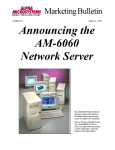


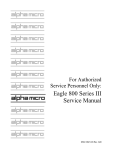

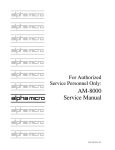

![CS4 - Intelligent Monitoring System [sp].indd](http://vs1.manualzilla.com/store/data/006224417_1-374e5606c4af92a845940d0315671aa2-150x150.png)



